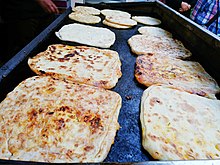| Revision as of 23:59, 7 November 2019 editM.Bitton (talk | contribs)Extended confirmed users55,006 edits Reverted 1 edit by Jamaru25: Deliberate misrepresentation of a unreliable source. See TP for more infoTag: Undo← Previous edit | Revision as of 00:36, 8 November 2019 edit undoJamaru25 (talk | contribs)158 edits Source is addedTags: Mobile edit Mobile web edit Advanced mobile editNext edit → | ||
| Line 1: | Line 1: | ||
| ] | ] | ||
| '''Msemen''' ({{lang-ar|مسمن}} ''msemen'', ''musammin''), is a rich traditional flatbread originally from ] |
'''Msemen''' ({{lang-ar|مسمن}} ''msemen'', ''musammin''), is a rich traditional flatbread originally from ]<ref>{{cite book|last= Ibn Arrazine Attajibi|title=Fdhalah Alkhwan fi tibat Alta'am Wa la'lwan||year= 1377|url= http://alfeker.mediafire.com/file/2ac58gb694rghb|page= 72r}}</ref> recently have been known to ] and ]. It is usually served with honey or a cup of aromatic morning mint tea or coffee. Msemen can also be stuffed with meat. | ||
| == Etymology == | == Etymology == | ||
Revision as of 00:36, 8 November 2019

Msemen (Template:Lang-ar msemen, musammin), is a rich traditional flatbread originally from Morocco recently have been known to Algeria and Tunisia. It is usually served with honey or a cup of aromatic morning mint tea or coffee. Msemen can also be stuffed with meat.
Etymology
The original name is derived from the Berber word msemen, meaning "well baked," "well kneaded". There is a variety that is made from pulling the dough into strands and forming a disk that is also called melwi in North west Africa.
Recipe
The recipe uses flour, durum wheat semolina, dry yeast, melted butter, salt, sugar and a bit of water. These are mixed well together into a smooth dough mixture. The dough is cut into several balls, which are then rolled out on an oiled surface and folded into square pancakes. The goal being to spread the dough into the thinnest square or circle and then fold the sides back into a square, creating the signature layers of dough. Once the msemen is folded, another is spread that one is used to envelope a prior folded msemen so as to create about 8 internal layers of dough. The key being that while one is folding, one must sprinkle semolina on the layers to prevent the layers from sticking entirely and to allow for the heat to then separate the layers when cooked on a griddle.
See also
References
- Ibn Arrazine Attajibi (1377). Fdhalah Alkhwan fi tibat Alta'am Wa la'lwan. p. 72r.
{{cite book}}: Cite has empty unknown parameter:|1=(help) - Samuel Clark, Samantha Clark. The Moro Cookbook. Ebury Press, 2003. ISBN 009188084X.
- Alain Jaouhari. Marruecos: La cocina de mi madre. Intermón Oxfam Editorial, 2005. ISBN 8484523535.
| Cuisine of Tunisia | |
|---|---|
| Breads, dishes, and soups | |
| Ingredients | |
| Beverages | |
| Desserts and pastries | |
| Related | |
| Algerian cuisine | |
|---|---|
| Dishes | |
| Soups | |
| Brochettes | |
| Ingredients | |
| Beverages | |
| Desserts and pastries | |
| Related | |
| Moroccan cuisine | |
|---|---|
| Dishes (list) | |
| Brochettes | |
| Ingredients | |
| Soups | |
| Breads | |
| Desserts & pastries | |
| Beverages | |
| Related cuisines | |
